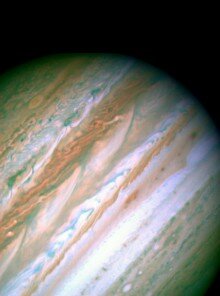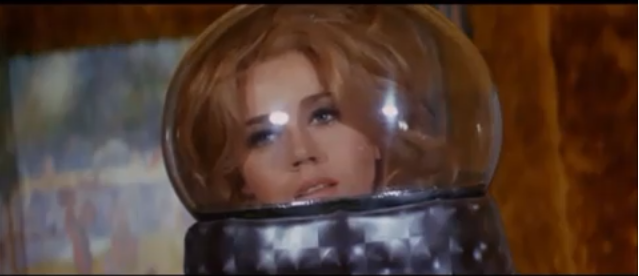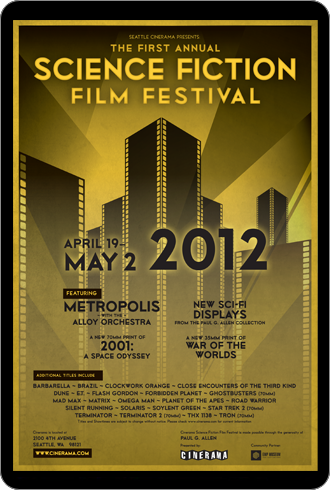The Seattle Symphony presents “The Planets — An HD Odyssey”, featuring music inspired by outer space, including works by Ligeti, R. Strauss, and Holst and images from NASA. The performance is on Saturday, July 14 at 8 p.m. at Benaroya Hall.
Despite the lure of a bright, balmy summer evening, Benaroya Hall was packed to the brim on Thursday night. A diverse crowd turned out for the Seattle Symphony‘s program of music inspired by outer space. The concert featured a performance of Holst’s beloved suite The Planets accompanied by HD images of the solar system projected on a large screen above the orchestra. Also on the program were two works from the soundtrack to the cinematic classic 2001: A Space Odyssey, Ligeti’s Atmosphères and Strauss’ dramatic Also sprach Zarathustra. After two nearly sold-out shows on Thursday and Friday, tickets are scarce for the remaining performance tonight.
The otherworldly sounds of Ligeti’s Atmosphères provided a fitting start to the evening’s program. This short, groundbreaking work, composed in 1961, focuses on sound and musical color — rather than melody and rhythm — to create a mood of quiet mystery. Soft, high notes from the strings blend with bubbles of sound from brass and woodwinds, generating a musical landscape evocative of today’s ambient and electronic music. At times, the score calls for two percussionists to move brushes across the strings of a grand piano, creating an eerie effect that was fascinating to see and hear.

After Atmosphères, conductor Ludovic Morlot launched straight into Zarathustra without a pause between the two works. What a dramatic effect! Ligeti’s piece faded away into nothing, and Strauss’ work launches from that silence into a bold, earthshaking fanfare, one of the grandest in the history of classical music. Though the rest of the work is not as well known as the introduction, it’s still full of exciting moments. The low brass section shone in the “Von der Wissenschaft” (“Of Science and Learning”) movement, introducing a dramatic motive that was passed around the orchestra.
The drama continued with The Planets, one of the most famous works by British composer Gustav Holst. Completed in 1916, this beloved piece continues to inspire composers today, especially those who write music for film. Although The Planets was composed just as modern cinema was beginning to take off, Holst’s colorful, vibrant melodies beg to be enhanced by equally rich visuals and storylines, whether on-screen or simply in one’s imagination.
NASA’s stunning images, video, and animations of the solar system provided an ideal accompaniment to the performance. It was a treat to see video footage taken from cameras on the Mars Rover as it traversed the arid surface of the Red Planet. The dark, brooding strains of the “Mars, The Bringer of War” movement matched the action perfectly as a computer-generated animation showed the Mars Rover being deployed and landing on the planet’s surface. Mesmerizing footage of the swirling clouds of gas surrounding Jupiter’s surface was made even more captivating by hearty folk-based melodies of “Jupiter, The Bringer of Jollity”.
Like Zarathustra, The Planets is an action-packed work full of orchestral color and memorable melodies. Outstanding playing from Assistant Concertmaster Emma McGrath and principal cellist Efe Baltacigil made for a poignant and touching duet in the “Venus, The Bringer of Peace” movement. “Neptune, The Mystic”, the haunting final movement, ends with the voices of a women’s choir fading away into the distance. The symphony’s treatment of this was particularly effective. The women of the Seattle Symphony Chorale stood out of sight at the back of the auditorium. When they began to sing, it felt like voices were rising up out of nowhere and then fading away again.
Though “light summer fare” like this may seem hokey to stalwart concertgoers, there’s a simple reason that performances like this attract near-capacity crowds away from the sunny skies: they’re downright fun. Why? First and foremost, the music is spectacular. These works are shining stars in the classical repertoire for a good reason. This is the music that makes us gasp, that gives us chills, that tugs at our heartstrings. Though music like this readily stirs the imagination, beautiful visuals like the NASA images enhance the experience of live performance and help audiences appreciate this great music from a new perspective. As the Seattle Symphony continues to grow in stature and reach out to new audiences, it’ll be interesting to see what sort of innovative programming arises from this winning concert formula.



